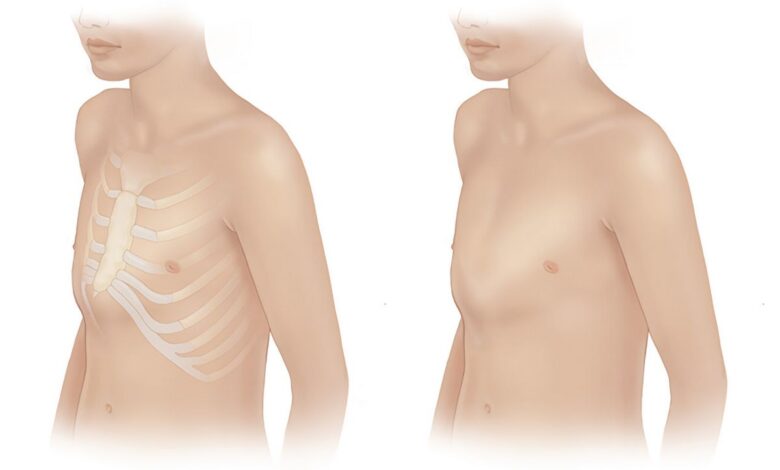Keeled chest, Pigeon chest in humans (Breast ship): What's it, causes, symptoms, diagnostics, treatment, prevention

Breast ship; Pigeon breast; Pigeon chest
What is a keeled chest?
Keeled chest, also known as Pectus carinatum, is a deformity of the chest, at which sternum (sternum) bulging forward, creating an appearance “keeled” Breast. This condition may be acquired or congenital., and most commonly occurs in childhood.. It can cause a variety of physiological and aesthetic problems in patients..
Causes of a keeled chest
Causes of keeled chest can be varied:
- Genetic predisposition: Hereditary factors may play a role in the development of a keeled chest.
- Impaired growth and development: Some cases of keeled chest are due to abnormal development of bones and cartilage in the chest region during growth..
- Errors in fetal position: Some studies show, that the incorrect position of the fetus in the womb can affect the formation of the chest.
- chest cancer: Rarely, keeled breasts can be caused by a tumor in the area..
Disease, that can cause keeled breast deformity may include:
- Congenital keeled chest (present at birth)
- Trysomyya 18
- Trysomyya 21
- Gomocistinuriя
- Marfan syndrome
- Morquio syndrome
- multiple freckle syndrome
- Brittle bones
In many cases the cause is unknown.
Symptoms of a keeled chest
Symptoms of a keeled chest may vary depending on the degree of deformity and the presence of comorbid conditions.. Main symptoms may include:
- Breast bulge: Anterior protrusion of the sternum creates a visible bulge on the chest.
- cosmetic problems: The appearance of a bulge on the chest can cause aesthetic inconvenience.
- Discomfort and pain: Some patients may experience discomfort, pain or pressure in the chest.
- Limitation of physical activity: In some cases, a keeled chest may limit full participation in physical activity..
When to see a doctor
If you or your child has signs of a keeled chest or if you notice unusual changes in the chest area, it is recommended to consult a doctor. The doctor will examine, diagnosis and determine the need for treatment.
Questions, which the doctor may ask
During a visit to the doctor, it is useful to ask the following questions::
- What is the cause of a keeled chest in me or my child?
- What is the degree of chest deformity?
- What diagnostic methods may be required?
- What treatment options are available and which one is right for me or my child?
Diagnostics of the keeled chest
Diagnosis of keeled chest may include:
- Medical checkup: The doctor will evaluate the appearance of the chest and perform a physical examination..
- Chest X-ray: X-rays can help determine the degree of deformity and its effect on internal organs..
- CT scan (CT) or magnetic resonance imaging (MRT): These methods can provide a more detailed image of the chest..
Treatment of keeled chest
Treatment for keeled chest may include:
- medical supervision: In some cases, especially with slight deformation, may only require regular monitoring without medical intervention.
- Orthopedic exercises: Orthopedic physical therapy can help strengthen chest muscles and improve posture.
- Surgical intervention: In severe cases, surgical correction of the deformity may be required to improve respiratory function and aesthetic appearance..
Home Treatment
Home treatment may include:
- Performing orthopedic exercises, suggested by the doctor.
- Maintaining a healthy lifestyle and physical activity.
- Follow post-surgery care guidelines (if it was carried out).
Prevention of keeled chest
Since most causes of keeled chest cannot be prevented, specific prophylaxis may be limited. However, maintaining a healthy lifestyle, strengthening chest and back muscles, as well as regular medical examinations can help to identify and manage the condition in a timely manner.
It is important to remember, that consultation with a physician and adherence to his recommendations play a key role in the effective prevention and treatment of keeled chest.
Used sources and literature
Hello SR. Skeletal diseases influencing pulmonary function. In: Kliegman RM, St. Geme JW, Bloom NJ, Shah SS, Tasker RC, Wilson KM, eds. Nelson Textbook of Pediatrics. 21st ed. Philadelphia, PA: Elsevier; 2020:chap 445.
Gottlieb LJ, Reid RR, Slidell MB. Pediatric chest and trunk defects. In: Rodriguez ED, Losee IS, Neligan PC, eds. Plastic Surgery: Volume 3: Craniofacial, Head and Neck Surgery and Pediatric Plastic Surgery. 4th ed. Philadelphia, PA: Elsevier; 2018:chap 40.
Kelly RE, Martinez-Ferro M. Chest wall deformities. In: Holcomb GW, Murphy JP, St. Peter SD eds. Ashcraft’s Pediatric Surgery. 7th ed. Philadelphia, PA: Elsevier; 2020:chap 20.
